This weekend I went on the second study tour with Fukushima Prefecture. I had already done many things that we did on this trip, but it was fun to do them again and learn some more things.
We started out going to the Fukushima Prefecture Environmental Creation Center. This time we did not have a lot of time, so they showed us the movie about Fukushima in their great, 360 degree video sphere room. And then they took us over to a 3d miniature model of the Daiichi Nuclear Power Plant and how exactly the meltdown happened and what the power plant looked like right after. They explained what happened with the failure of their fail-safes and how certain things worked properly. It was quite educational and I enjoyed it.
There was also this machine that simulated visually what particles from space look like.
As well as this electric machine that flashes light when it detects particles from space passing through the field.
We didn’t get to spend a lot of time there because we were running late. So we piled onto the bus and went to our next destination, Bandai in Aizu, Fukushima.
We went there to eat some famous ramen and tonkatsu. (I wrote about this place in my Daikannon post a few weeks ago, go check it out!)
From the parking lot you can see the entrance to the great Kannon-Sama statue in Bandai.
After that we head over to Aizuwakamatsu up to the water spring coming from the mountain where the Byakkotai squad committed suicide. (For more info check out my Let’s Aizu-ing post.)
Before we went to check out the historical stuff on the hill, we went into a small shop where they had manji-making lessons upstairs. We were able to make our own manju out of anko balls and millet. We packed the millet into a small cup and then put the anko ball in the middle. We then put more millet on top and packed it all together. Then you lightly tap the sides of the cup and then tip it upside down onto the floor of a wooden tray.
My first manju I hadn’t packed it tight enough so it fell apart a little bit, but I was able to fix it. After that I had no problem packing it tight enough.
We placed our manju in a line and had a lable for our line made from duct tape.
Poor Brendan, he just didn't get it, he never packed the manju tight enough, no matter how hard he tried...
 |
| Guess which line of manju was Brenden's. |
After we made our manju, we went off to see some more history from the Iimori Hill while our manju cooked.
We also went into a small museum at the base of Iimori Hill. The tour guide in the museum told us about some of the history surrounding the Byakkotai, as well as the influential families and Daimyo of the area. He said that his family had been documenting the history of the Aizuwakamatsu area for generations.
In this museum there was a cannon that was used in the Boshin war. It had twisting ridges in its barrel. This would spin the cannonball and make it more accurate.
They also had a bunch of guns and bullets and tools on display for the weaponry used in the Boshin war.
From here we walked over to the Aizu Sazaedo temple, or the unique double-helix temple. Here you can see an illustration of what the layout of the temple is. (Again you can see more detail in my Let’s Aizuing! post.)
From here we went back down to the shop where our manju had finished cooking and they were currently packing it up into little boxes for us to take our manju home with us.
From here we went over to a samurai school called Aizu Hanko Nisshin-kan. It was a school for children of samurai so they could learn how to become samurai as well.
The school has some of the most bad-ass komainu at its entrance that I have ever seen.
The children entered the school at age ten where they were given academic as well as physical classes and martial arts in order to become trained samurai.
It was at this school that the Byakkotai samurai squad got their education.
The school boasts of having one of the oldest (if not the oldest) swimming pool in japan. The boys were expected to learn how to swim and maneuver in water in full armor and with horses.
The school also claims to have been the start of school lunches in Japan, although I have heard that is not completely correct and the school lunch was an American influence from World War II, but who knows.
 |
| Rules for being a good student. |
The school had been partly burned down, but it has been rebuilt true to its original design.
There was a nice temple on the grounds as well.
The school had many wax figures on display to illustrate what life was like in the samurai school.
Here is a photograph of Aizuwakamatsu Castle, or Tsuruga Castle. You can see how damaged the castle is. It took a lot of damage from cannon fire during the war.
There was also a model that shows the same thing.
Here are some old karuta “cards”, they are made from wood.
And it wouldn't be complete without a grusome representation of the Byakkotai boys.
At the end of the tour of the school there was an archery range, where a few of us tried our hands at archery.
The only ones who could hold the bow steady were Cormac and Felipe. Cormac has been taking Kyudo (archery) lessons. He’s pretty impressive, I say.
This was the beautiful view we were treated to as we left the school.
The sun was setting at this point, so we were herded back onto the bus and drove to our last destination of the day, a ski resort near Lake Inawashiro, the second biggest lake in Japan. That night we were given lodging and a meal. We also went to hang out in a nice onsen that had both indoor and outdoor pools. The outdoor pool had large chunks of daikon radish floating in the water. After that we hung out in some one’s room until after midnight socializing. But we went to bed before too long because we had a fun day ahead of us.















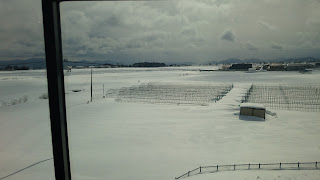












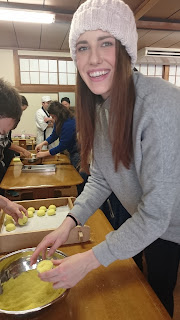









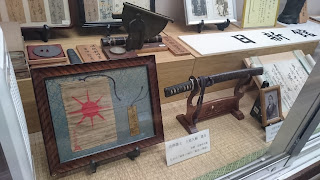

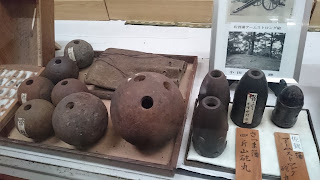










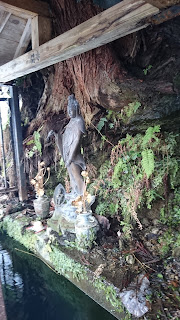





























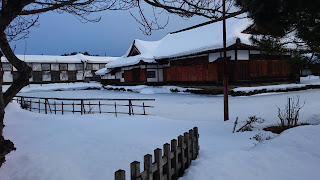



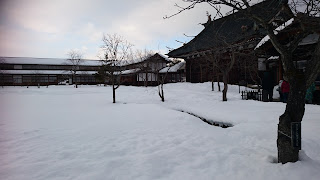

















No comments:
Post a Comment